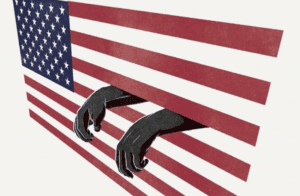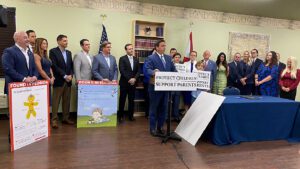Today, 25 percent of the world’s documented prison population is incarcerated in the United States. Despite America being the land of the free, there are more recorded prisoners here than in any other country: 2,068,800.

So, how did the United States get here? Over the last 40 years, numerous factors have contributed to the dramatic increase in the prison population. President Richard Nixon declared a “war on drugs” in 1971. Ensuing legislation, such as the Anti-Drug Abuse Act of 1986 and the Violent Crime Control and Law Enforcement Act of 1994, contributed to a rapid increase in the U.S prison population. Years earlier, even the 13th Amendment to the Constitution contributed to the growth of the prison population.
The 13th Amendment reads, “Neither slavery nor involuntary servitude, except as a punishment for crime whereof the party shall have been duly convicted, shall exist within the United States, or any place subject to their jurisdiction.” Some refer to this clause as the criminal-exception loophole, which allowed the economic benefits of slavery to continue by prosecuting and imprisoning Black Americans for petty, ill-defined crimes such as vagrancy.
After the Civil War, Southerners struggled with the sudden lack of free labor and the economy began to deteriorate. To offset that stress, some states began the practice of convict leasing and enforcing Black Codes. This allowed prisoners to be leased out for their labor to those who paid small leasing fees to the government. Because Black Codes criminalized freed slaves for frivolous reasons such as lack of employment, lack of housing, or participating in business other than husbandry, there was quickly a plethora of laborers to lease out.1
This loophole introduced long-term consequences that are still catching up with us today. The effects of the 13th Amendment and current laws continue to allow convicted felons to be compelled to work without pay. And some legislators regard the U.S.’s highest incarceration rate as a pressing current issue.
How Citizens Feel About Our High Incarceration Rate in America
In 2017, the American Civil Liberties Union (ACLU) Campaign for Smart Justice conducted a public poll to gain a greater understanding of how individuals view the high incarceration rate in America. Of those polled, 71 percent agreed that it is important to reduce America’s prison population. That 71 percent included 87 percent of Democrat respondents, 67 percent of independent respondents, and 57 percent of Republican respondents. The poll found that 68 percent of respondents would be more likely to vote for an elected official who supports reducing the prison population, and that 71 percent believe incarceration is counterproductive to public safety. Other studies and polls show similar results that liberals, conservatives, and moderates, for the most part, find some agreement on the high incarceration rate in America as a current issue.2
Sen. Charles Grassley (R-Iowa) and former Gov. Deval Patrick (D-Mass.) discuss sentencing reform and reducing rates of incarceration:
What Are Some Possible Solutions?
One proposed approach to reducing the incarceration rate is to begin back-pedaling on some laws passed with the Anti-Drug Abuse Act of 1986 and the 1994 Crime Bill. President Donald Trump signed into law the First Step Act of 2018, which passed Congress with overwhelming bipartisan support.3 The main goals of the law were sentencing and prison reform. The law gave sentencing power back to judges by allowing them to reduce sentences below the statutory minimum; offenders who were sentenced for crack-cocaine-related charges prior to 2010 were automatically allowed to apply for resentencing. There were also a multitude of reforms to how corrections officials treat prisoners and certain aspects of how the Department of Justice and attorney general interact with the Bureau of Prisons and the Department of Corrections to make living and labor conditions better for inmates.
READ: “Criminal Justice Reform: The First Step Act” on the Current Issues Blog
Another prospective solution is to amend the Constitution. In 2020, congressional Democrats proposed legislation to add an amendment to the Constitution that would eliminate the language that permits slavery and involuntary servitude as criminal punishment and make them unconstitutional under any conditions. Sen. Jeff Merkley (D-Ore.) argued for the bill’s passage, saying that the 13th Amendment “continued the process of a white power class gravely mistreating Black Americans, creating generations of poverty, the breakup of families, and this wave of mass incarceration that we still wrestle with today.” Former Rep. William Lacy Clay (D-Mo.) said such a change to the Constitution would “finish the job that President Lincoln started.”4
Although this constitutional amendment did not pass, some states are passing similar legislation to amend their own constitutions. In 2018, Colorado put a measure on the state ballot to remove the language permitting slavery from the state constitution and became the first state to do so since the 19th century. Two years later in 2020, Nebraska and Utah passed similar legislation by ballot. Then, in 2022, voters in Alabama, Oregon, Tennessee, and Vermont officially made all forms of slavery illegal in their states.5
Supporters of these amendments argue that they will help rid America of modern-day forced labor in the prison system. Most prisoners are made to work during their incarceration. For example, much prison maintenance and upkeep is done by prisoners for $1 per hour or less. Activists say that compelling prisoners to work for such little money is synonymous with involuntary servitude, and they argue that passage of these amendments could balance morality scales and give prisoners more opportunity to save money to support themselves upon their release, thereby reducing recidivism rates and keeping communities safer.
Opponents, however, see a different view. They point out that allowing prisoners to collect higher wages would be difficult and expensive. For example, the California Department of Finance has estimated that it could cost $1.5 billion to pay prisoners the minimum wage. Opponents believe that such a move would reduce the beneficial impacts of certain prison programs that allow inmates to acquire job training and skills while working for no pay—programs that can assist them in having a more successful reentry to society.6
Discussion Questions
- How high a priority issue, if at all, do you think the high incarceration rate in the United States is? Explain your reasoning.
- What would be some benefits of taking steps toward reducing the incarceration rate? What would be some drawbacks?
- Do you think the criminal-exception loophole allows slavery and involuntary servitude to exist today? If so, how? If not, why not?
- When it comes to prison labor, do you believe inmates should have a choice to work or should they be compelled to work? Do you think they should be paid more to work or not? Explain your reasoning.
- Of the proposed policies mentioned above (or another that you have heard of), which do you believe would have the greatest impact on reducing the incarceration rate?
As always, we encourage you to join the discussion with your comments or questions below.
Close Up is proud to be the nation’s leading nonprofit civic education organization, working with schools and districts across the country since 1971. If you would like to partner with us or learn more about our experiential learning programs, professional development, or curriculum design and consulting, contact us today!
Sources
Featured Image Credit: Cornell Chapter of Amnesty International
 The survey’s key findings relating to the 2024 election and the presidential candidates include the following:
The survey’s key findings relating to the 2024 election and the presidential candidates include the following: The findings also show that young Americans have more negative emotional responses to the election, with half of respondents saying that they are feeling either “nervous and scared” or “dissatisfied and disappointed.” These responses can be partially explained by the findings that majorities of young Americans agree with statements such as:
The findings also show that young Americans have more negative emotional responses to the election, with half of respondents saying that they are feeling either “nervous and scared” or “dissatisfied and disappointed.” These responses can be partially explained by the findings that majorities of young Americans agree with statements such as:

 Karim Khan, prosecutor of the International Criminal Court (ICC), announced on May 20 that he has applied for arrest warrants for leaders of Hamas and Israel for war crimes and crimes against humanity over the October 7 attacks on Israel and the subsequent war in Gaza. A panel of judges will now consider Khan’s application for warrants for Yahya Sinwar, head of Hamas in the Gaza Strip; Mohammed Diab Ibrahim Al-Masri, commander-in-chief of the military wing of Hamas; Ismail Haniyeh, head of Hamas’ Political Bureau; Israeli Prime Minister Benjamin Netanyahu; and Israeli Minister of Defense Yoav Gallant.1
Karim Khan, prosecutor of the International Criminal Court (ICC), announced on May 20 that he has applied for arrest warrants for leaders of Hamas and Israel for war crimes and crimes against humanity over the October 7 attacks on Israel and the subsequent war in Gaza. A panel of judges will now consider Khan’s application for warrants for Yahya Sinwar, head of Hamas in the Gaza Strip; Mohammed Diab Ibrahim Al-Masri, commander-in-chief of the military wing of Hamas; Ismail Haniyeh, head of Hamas’ Political Bureau; Israeli Prime Minister Benjamin Netanyahu; and Israeli Minister of Defense Yoav Gallant.1

 Conservation efforts to promote native habitat hardly ever make national headlines, but they have been a consistent part of both federal and state government initiatives for decades. However, if you live in states such as Missouri, Kansas, and Virginia, you may have seen your state government take up environmental legislation this past week against the Bradford pear tree, an invasive tree that gained its fame for a particularly foul smell and is already restricted in ten other states.
Conservation efforts to promote native habitat hardly ever make national headlines, but they have been a consistent part of both federal and state government initiatives for decades. However, if you live in states such as Missouri, Kansas, and Virginia, you may have seen your state government take up environmental legislation this past week against the Bradford pear tree, an invasive tree that gained its fame for a particularly foul smell and is already restricted in ten other states.
 In the years following students’ return to in-person classes after the COVID-19 outbreak, questions about parents’ role in education and curriculum development—and the appropriateness of discussing controversial topics such as sex and gender orientation in the classroom—have come to the forefront of political debate.
In the years following students’ return to in-person classes after the COVID-19 outbreak, questions about parents’ role in education and curriculum development—and the appropriateness of discussing controversial topics such as sex and gender orientation in the classroom—have come to the forefront of political debate. On January 31, Harvard and Stanford Universities released the Education Recovery Scorecard, an assessment of student achievement following the COVID-19 pandemic learning loss.1 The report detailed the gains third- through eighth-grade students in 8,000 school districts across the country have made in their math and reading scores.2 The Education Recovery Scorecard results show that there has been significant recovery in these two subjects, though more needs to be done to help students reach basic levels of proficiency.
On January 31, Harvard and Stanford Universities released the Education Recovery Scorecard, an assessment of student achievement following the COVID-19 pandemic learning loss.1 The report detailed the gains third- through eighth-grade students in 8,000 school districts across the country have made in their math and reading scores.2 The Education Recovery Scorecard results show that there has been significant recovery in these two subjects, though more needs to be done to help students reach basic levels of proficiency.






